
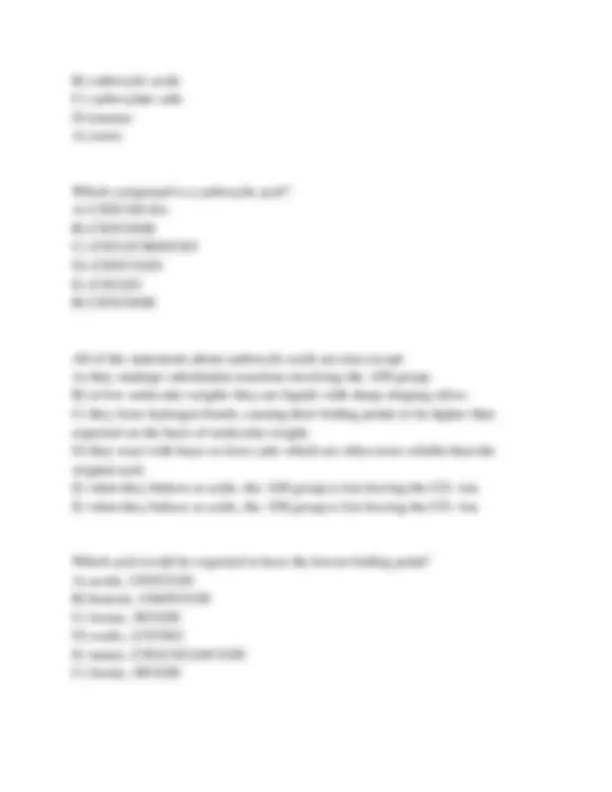
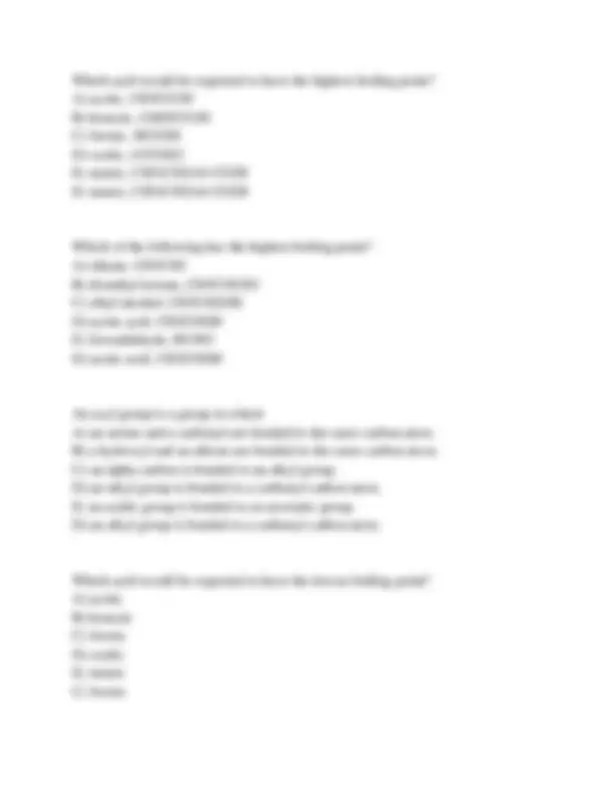
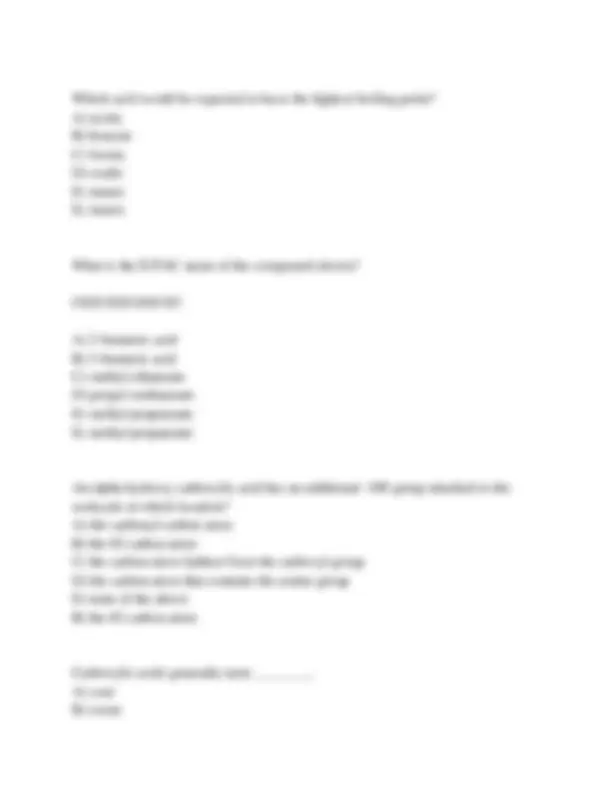
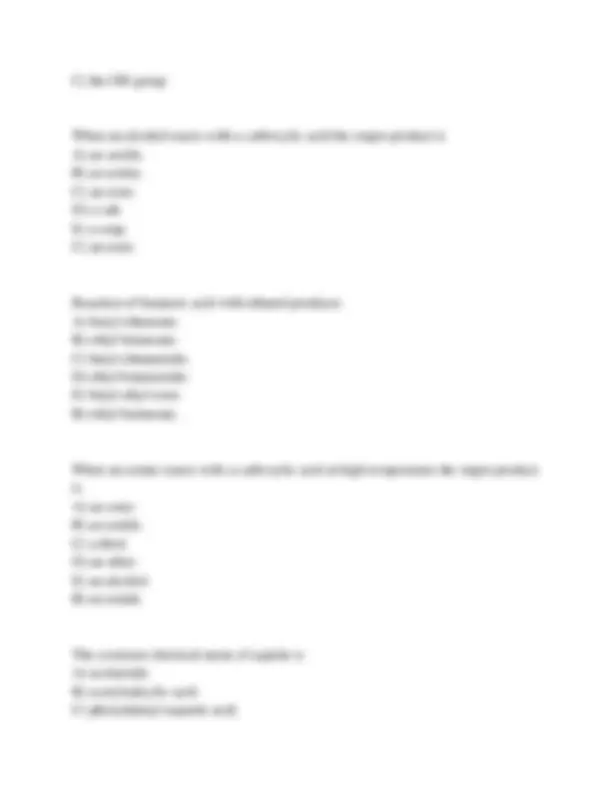
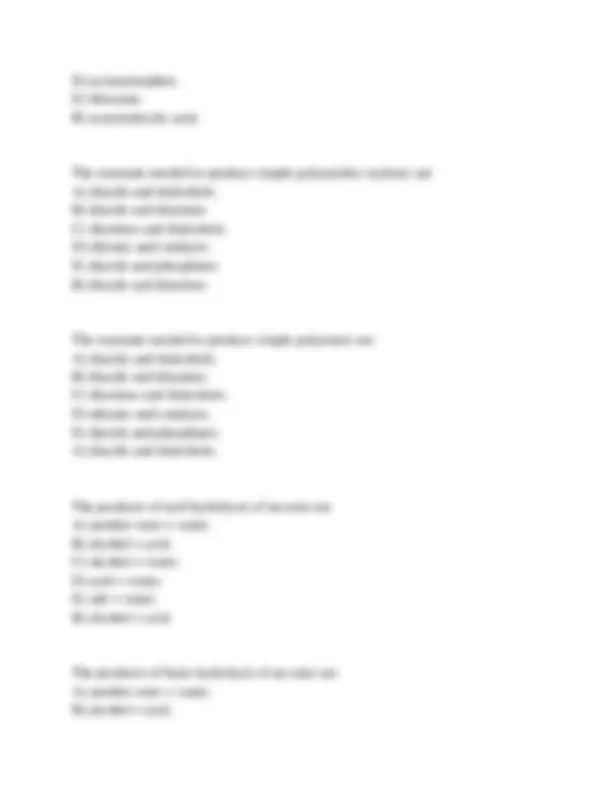
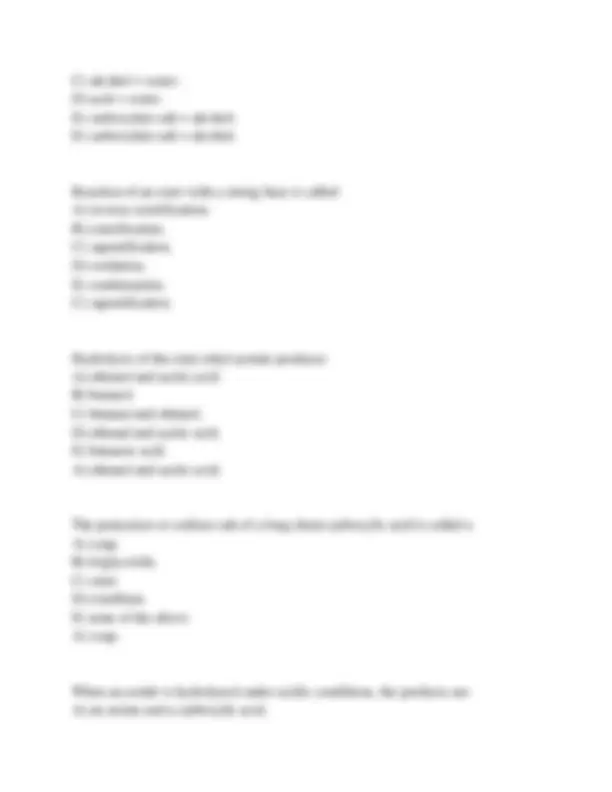
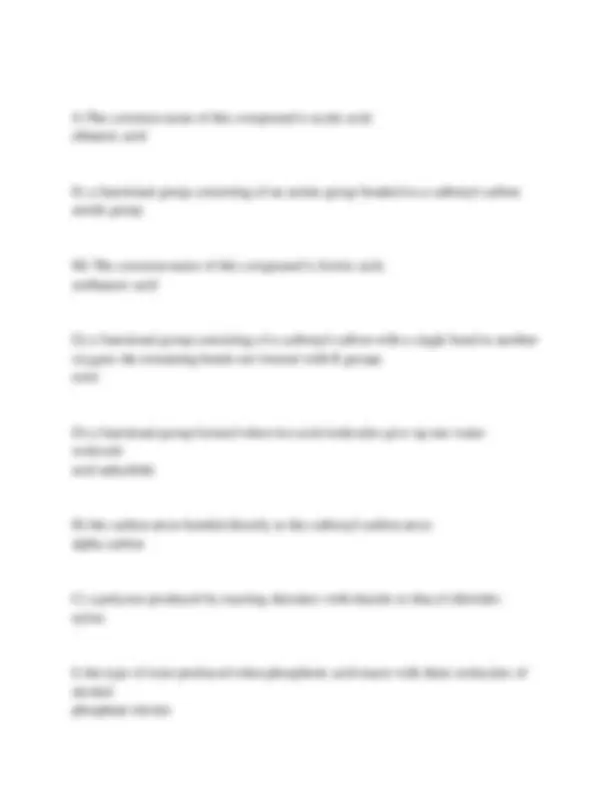
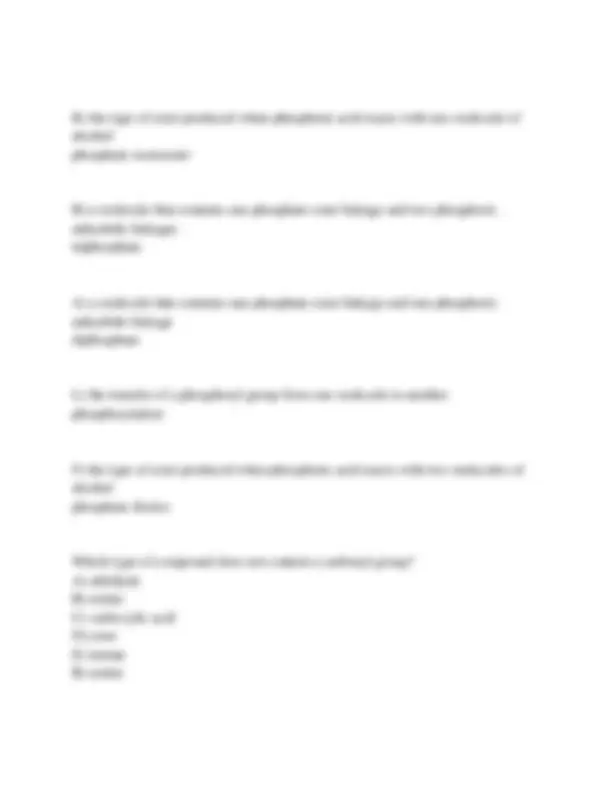
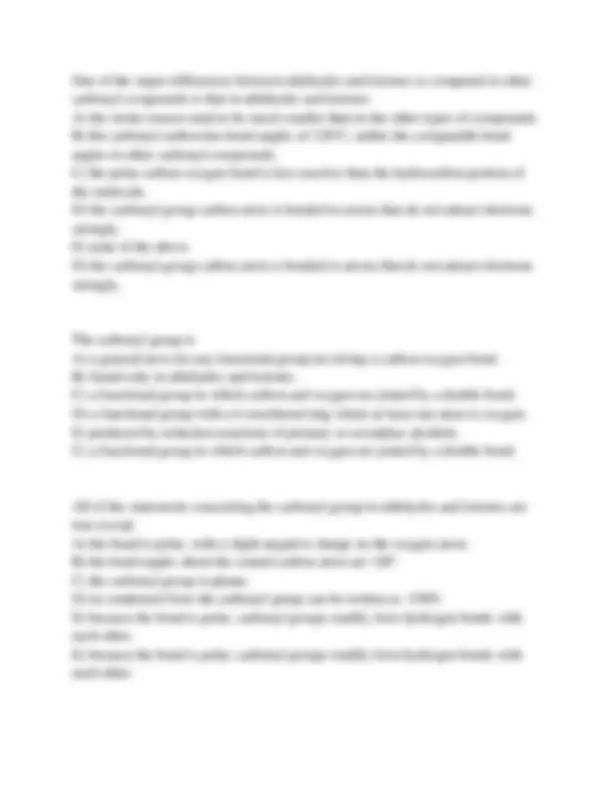
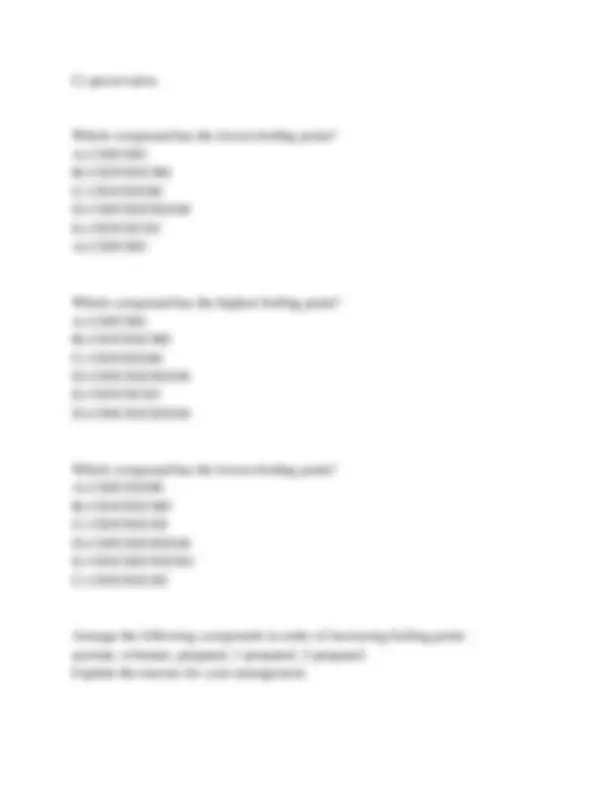
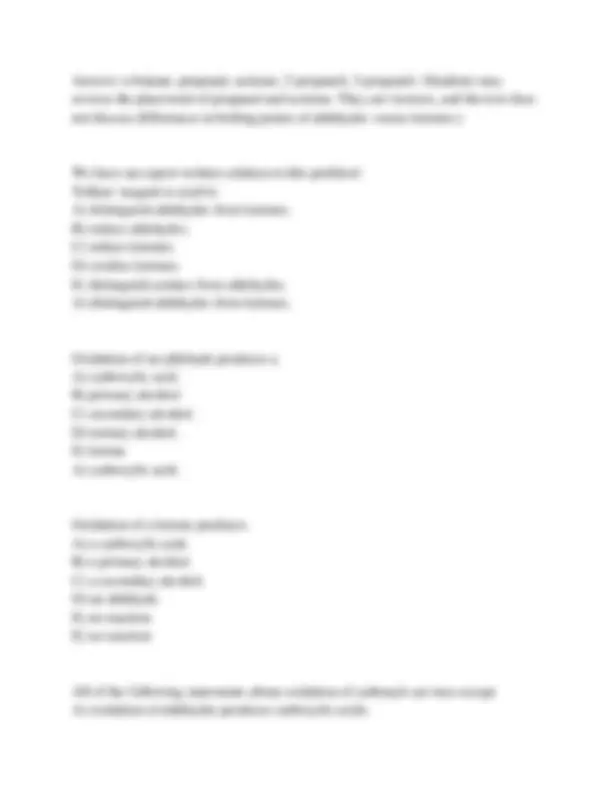

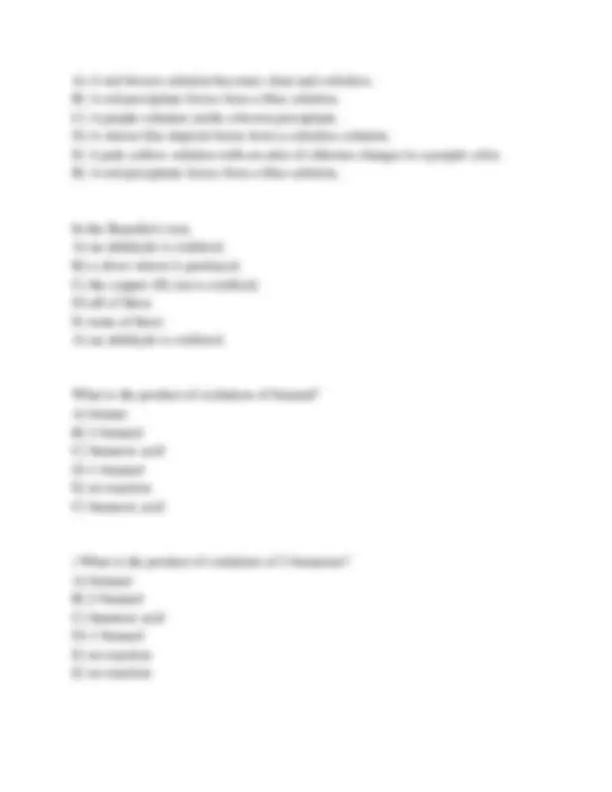
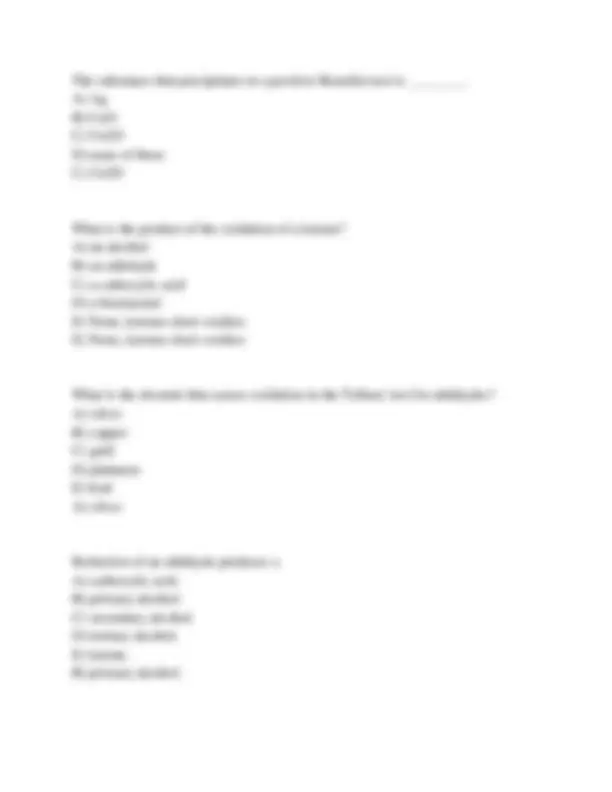
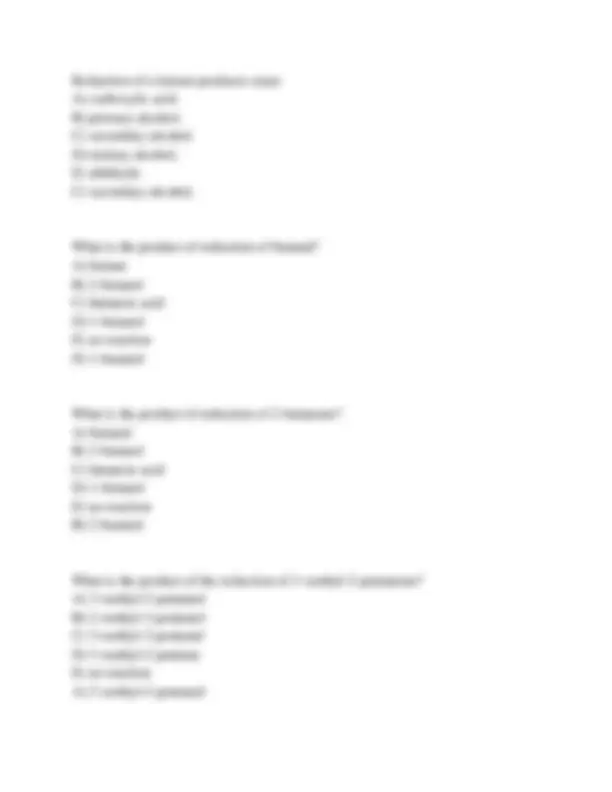
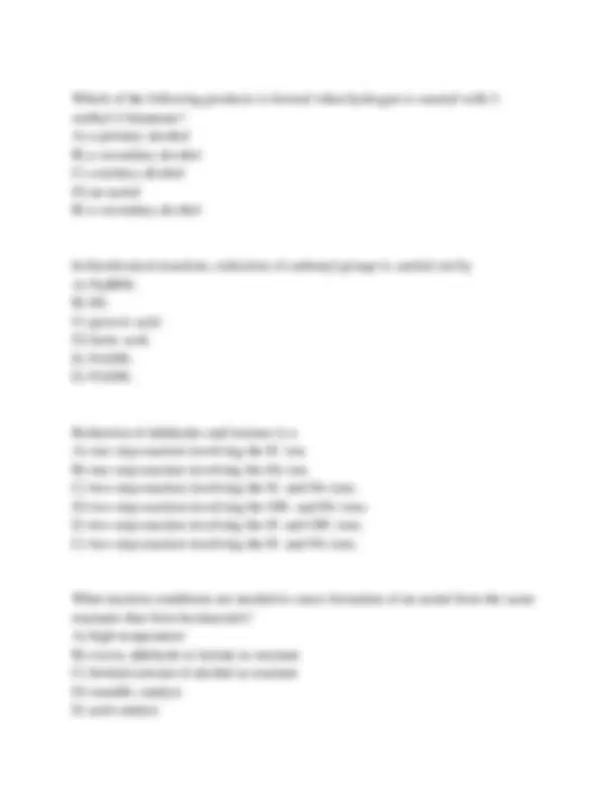
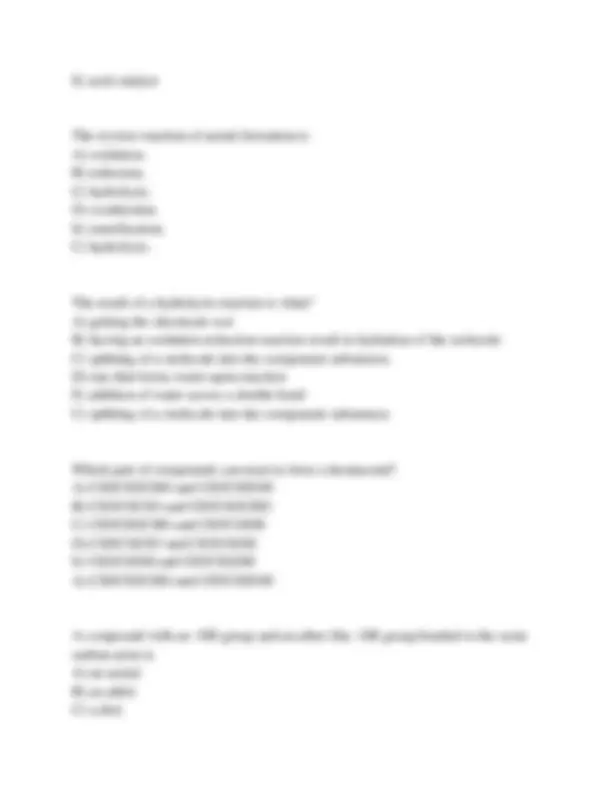
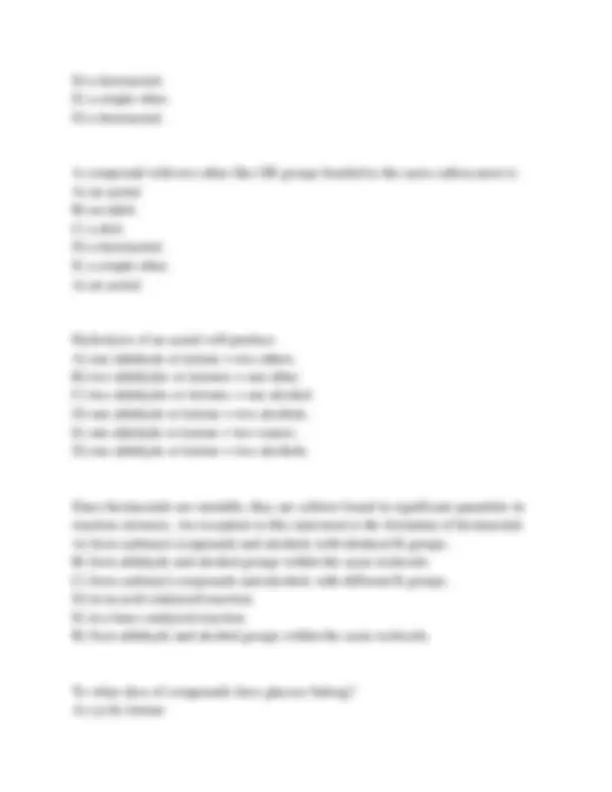
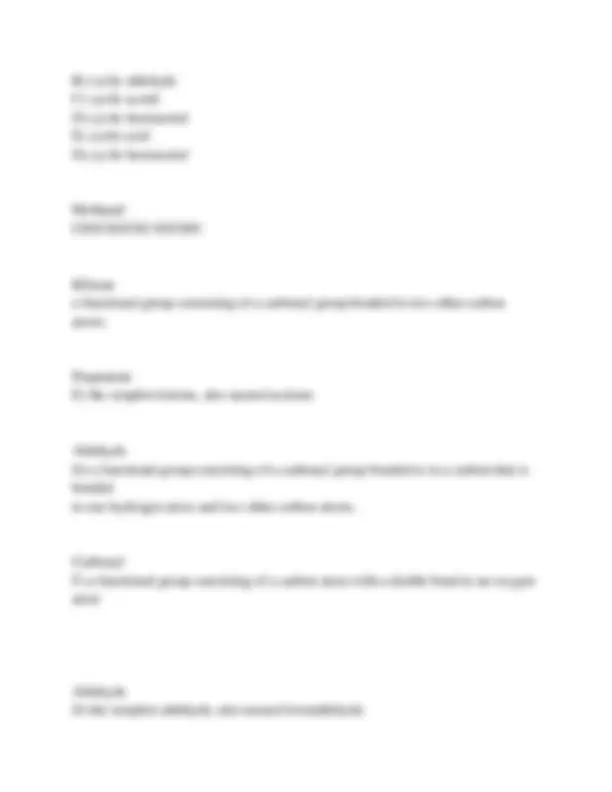
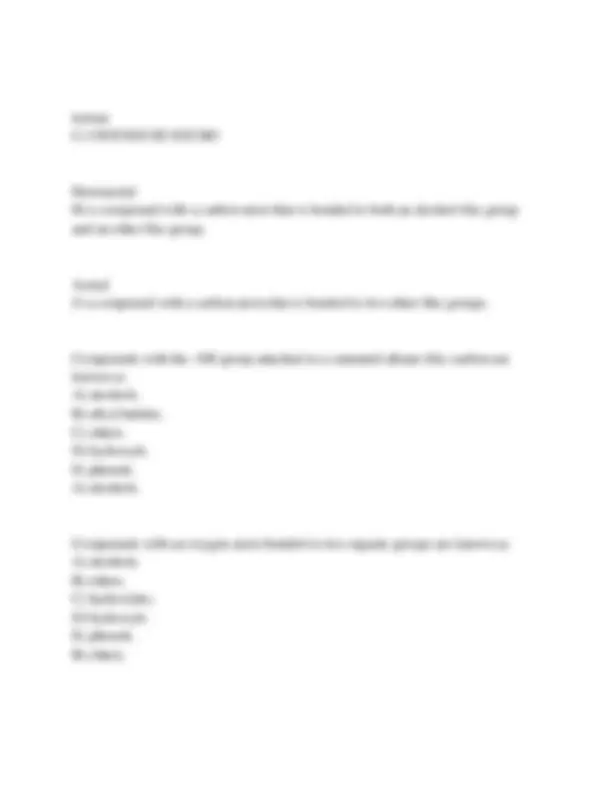
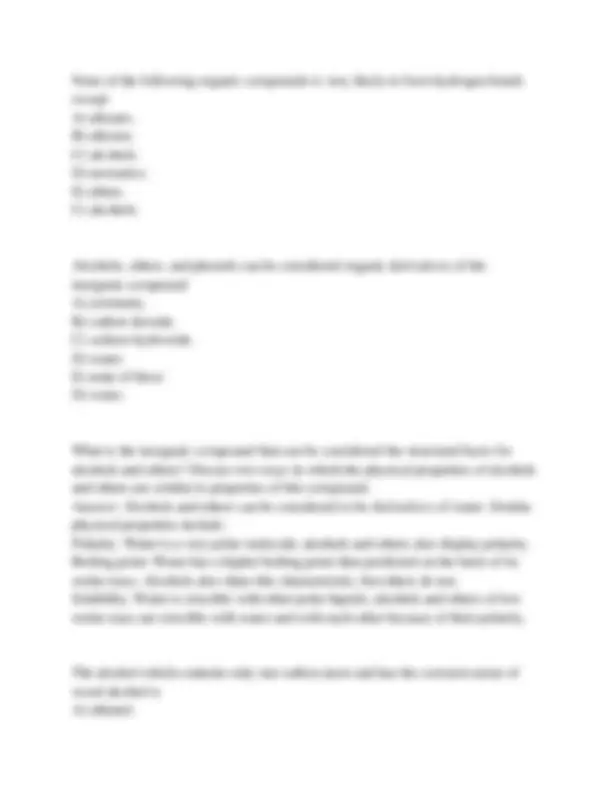
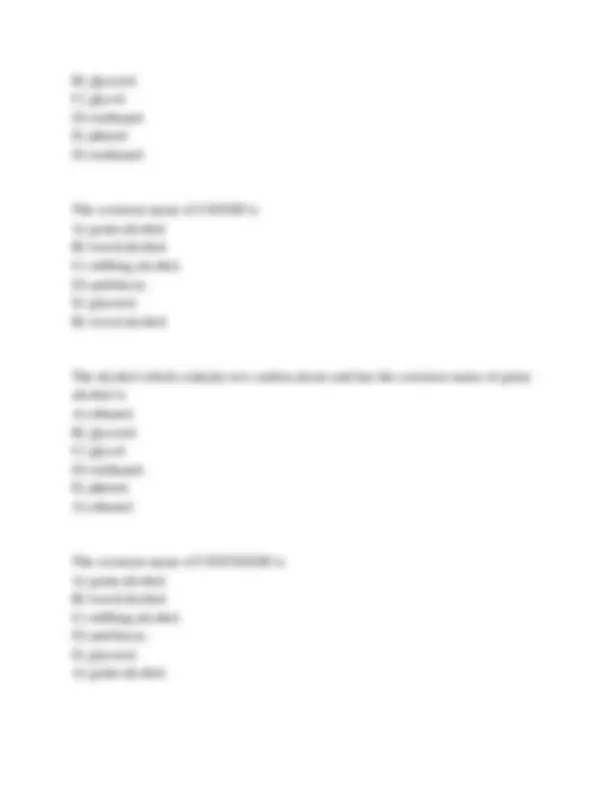
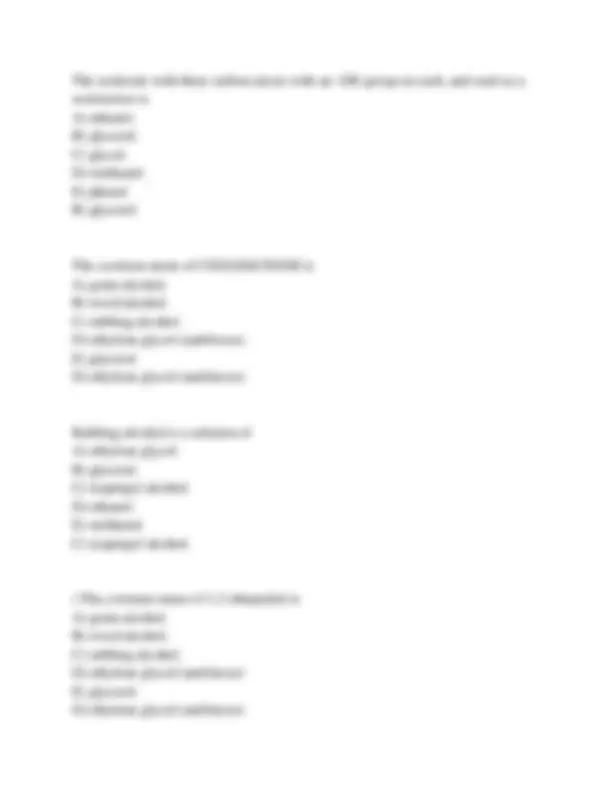

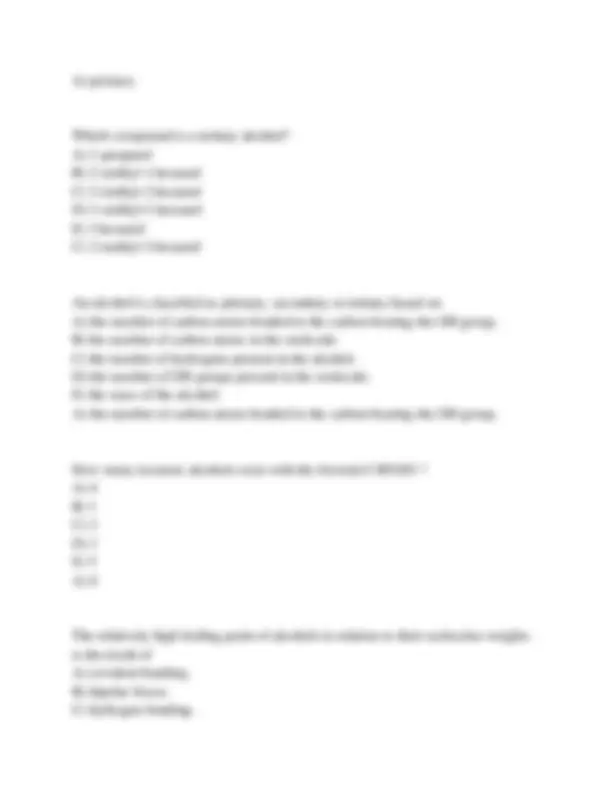

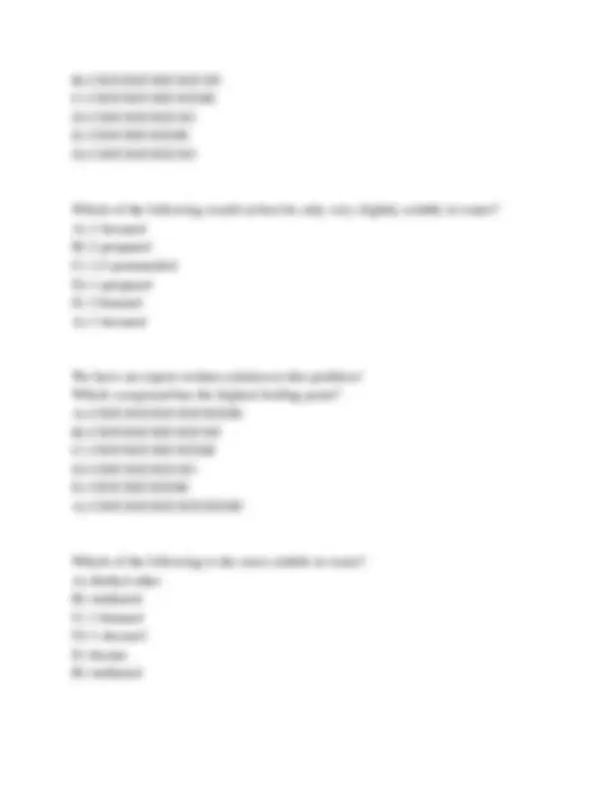
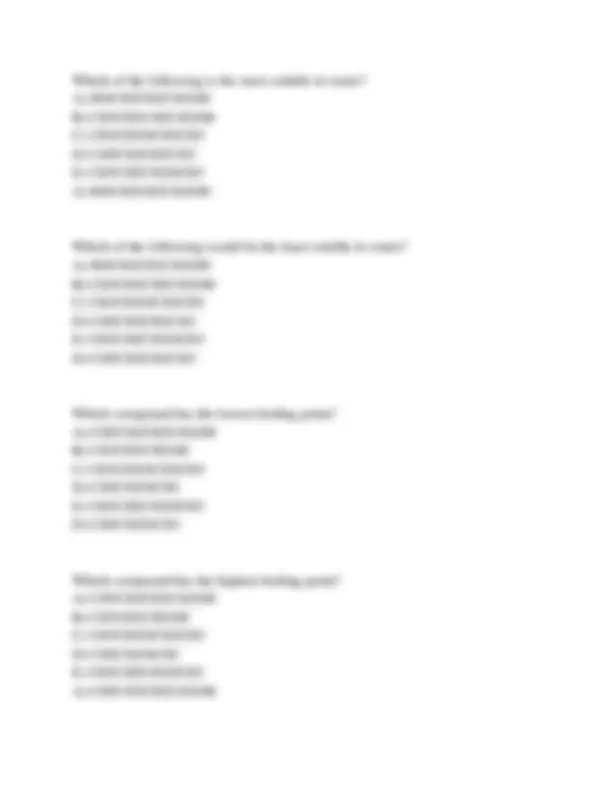
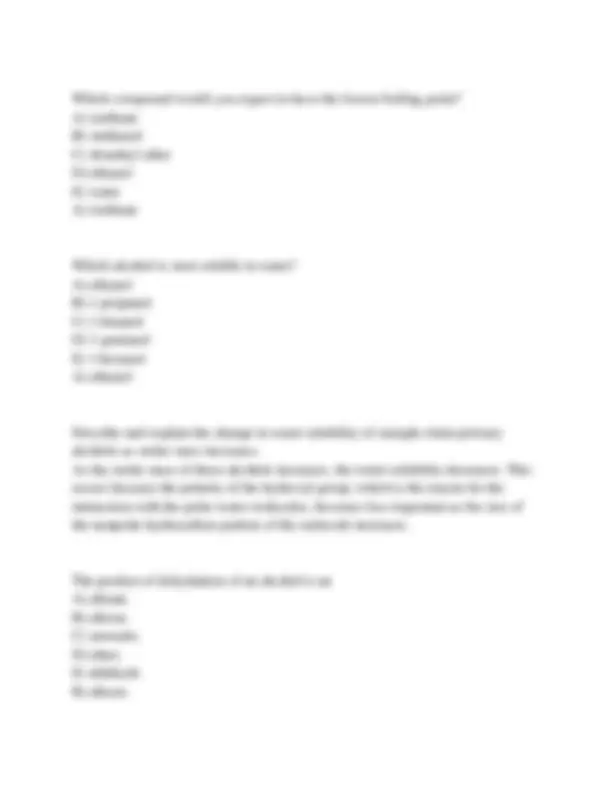
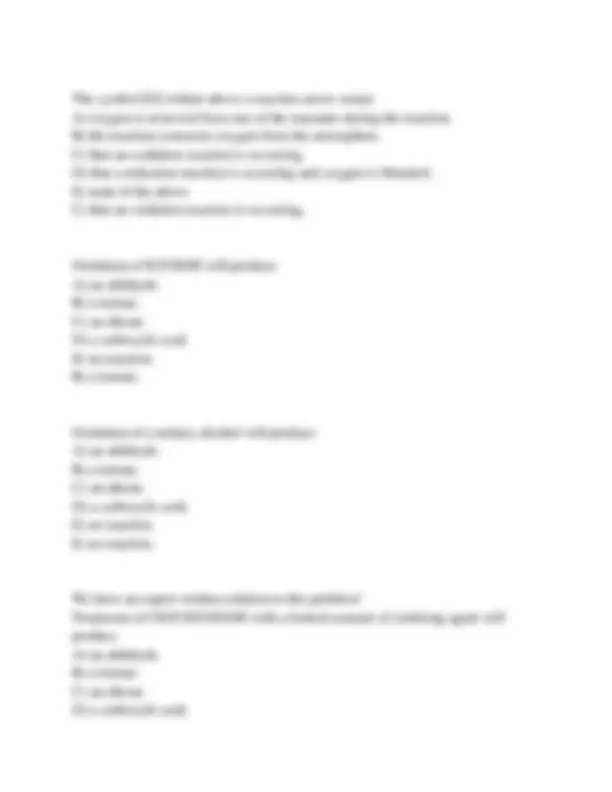
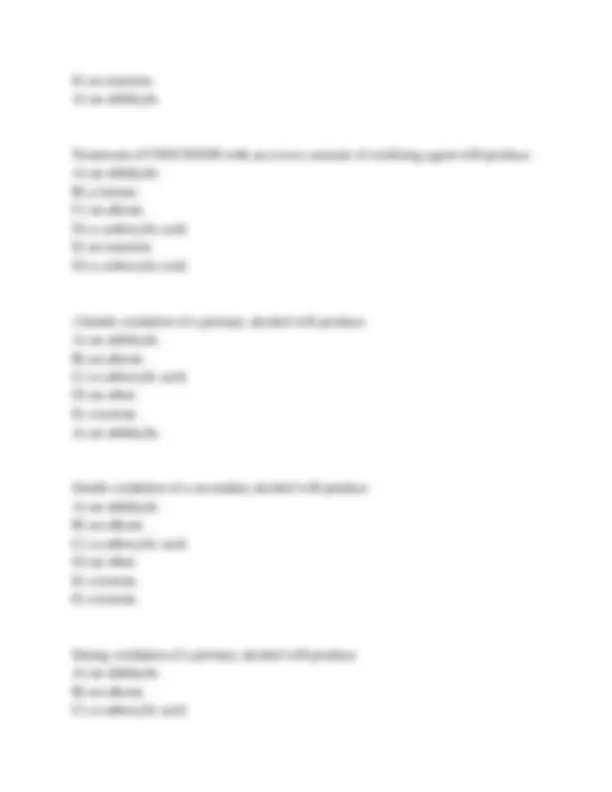
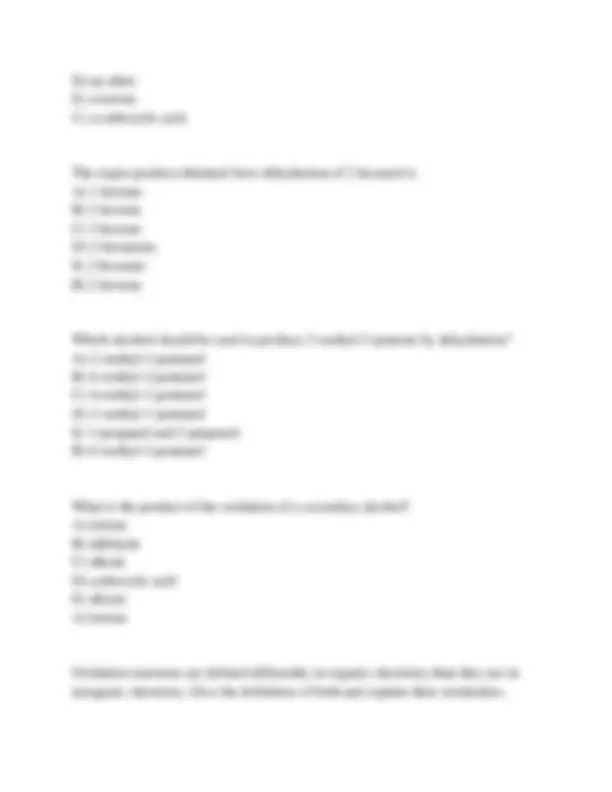
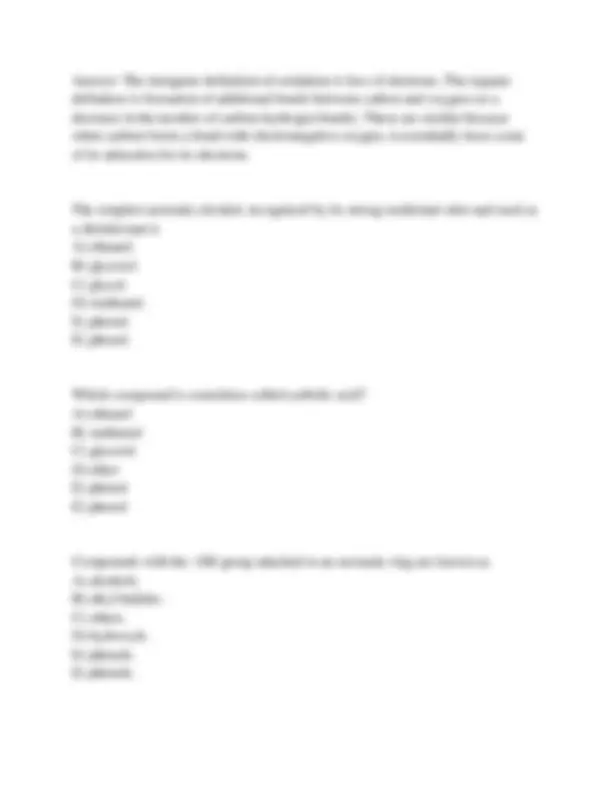
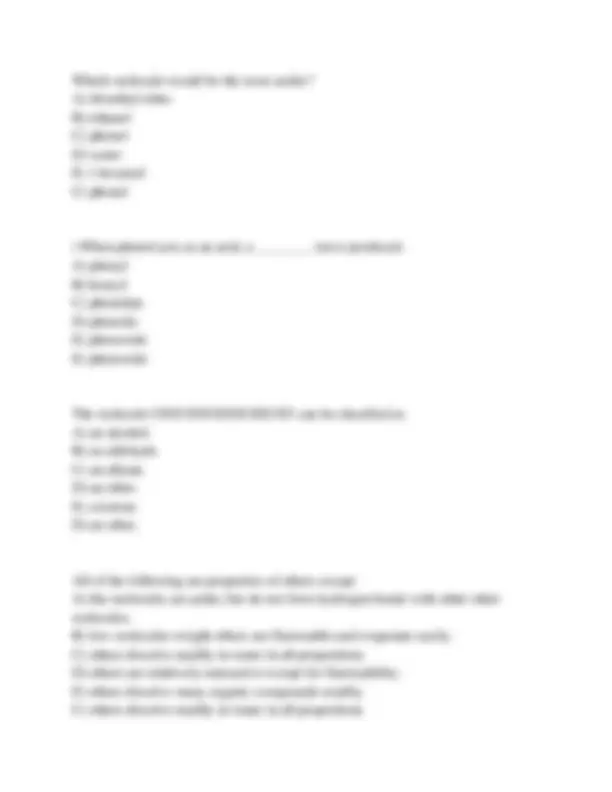
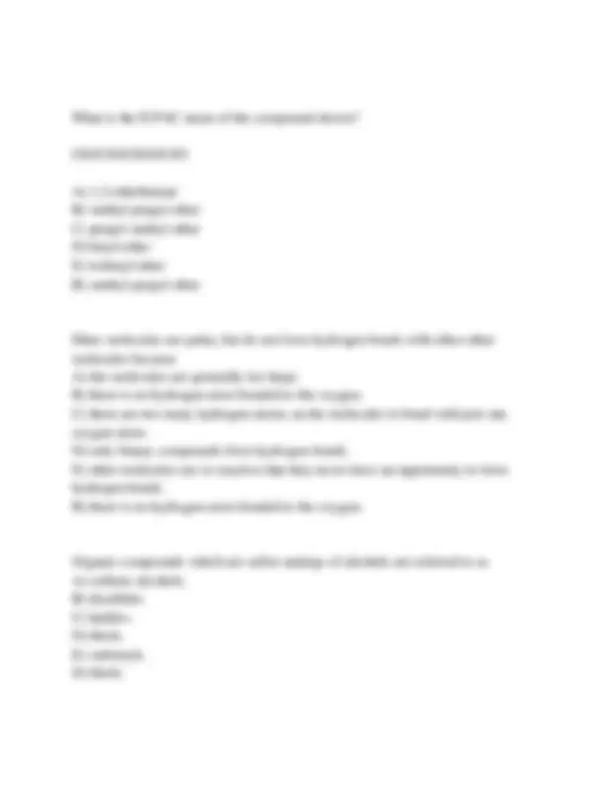
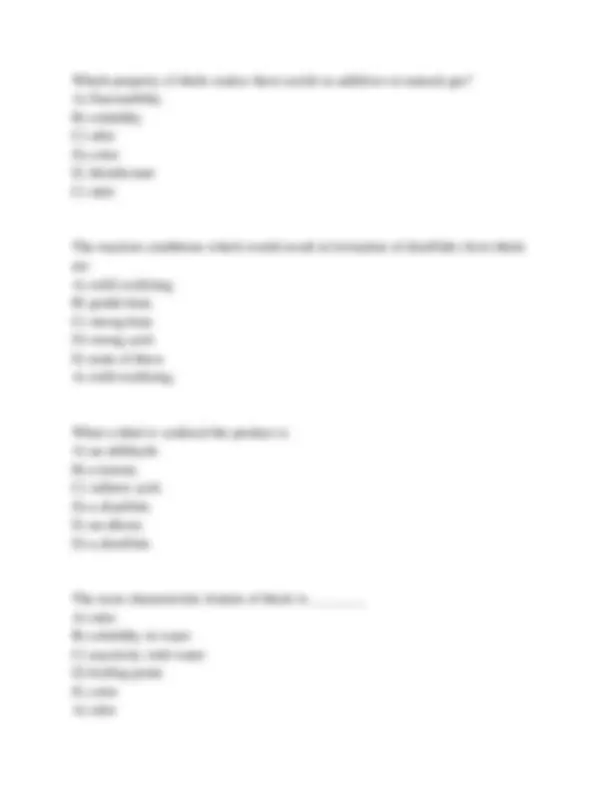
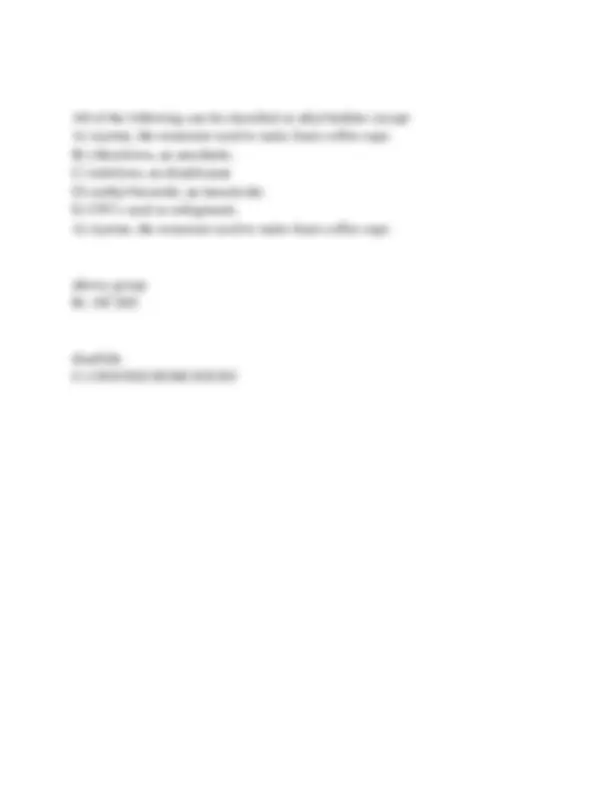


Study with the several resources on Docsity

Earn points by helping other students or get them with a premium plan


Prepare for your exams
Study with the several resources on Docsity

Earn points to download
Earn points by helping other students or get them with a premium plan
Community
Ask the community for help and clear up your study doubts
Discover the best universities in your country according to Docsity users
Free resources
Download our free guides on studying techniques, anxiety management strategies, and thesis advice from Docsity tutors
CHEM TEST BANK 2025-2026. QUESTIONS WITH CORRECT ANSWERS. A+ GRADED. ) Which functional group contains a carbonyl group and a hydroxyl group bonded to the same carbon atom? A) Aldehyde B) amide C) carboxylic acid D) ester E) ketone C) carboxylic acid ANS Which functional group contains a carbonyl group and an ether linkage bonded to the same carbon atom? A) aldehyde B) amide C) carboxylic acid D) ester E) ketone D) ester ANS
Typology: Exams
1 / 45

This page cannot be seen from the preview
Don't miss anything!






































) Which functional group contains a carbonyl group and a hydroxyl group bonded to the same carbon atom? A) Aldehyde B) amide C) carboxylic acid D) ester E) ketone C) carboxylic acid
Which functional group contains a carbonyl group and an ether linkage bonded to the same carbon atom? A) aldehyde B) amide C) carboxylic acid D) ester E) ketone D) ester
The similarities in properties of carboxylic acids, esters, and amides can best be explained by A) their polarity and structural similarities. B) their similarities in molar mass. C) hydrogen bonding. D) the ease with which they form ions.
E) none of these. A) their polarity and structural similarities.
The most common reactions of carboxylic acids or their derivatives involve A) addition across the double bond between carbon and oxygen. B) replacement of the oxygen atom in the carbonyl group. C) replacement of the group bonded to the carbonyl atom. D) oxidation of the R group. E) reduction of the R group. C) replacement of the group bonded to the carbonyl atom.
All of the statements concerning citric acid are true except A) it contains three carboxylic acid groups because its carbon skeleton is branched. B) it is very soluble in water. C) its salts are used in many consumer products. D) it is produced only by plants. E) it is a weak acid. D) it is produced only by plants.
The pleasant, characteristic odor of fruit flavorings is often associated with the presence of A) esters
Which acid would be expected to have the highest boiling point? A) acetic, CH3CO2H B) benzoic, C6H5CO2H C) formic, HCO2H D) oxalic, (CO2H) E) stearic, CH3(CH2)16 CO2H E) stearic, CH3(CH2)16 CO2H
Which of the following has the highest boiling point? A) ethane, CH3CH B) dimethyl ketone, CH3COCH C) ethyl alcohol, CH3CH2OH D) acetic acid, CH3COOH E) formaldehyde, HCHO D) acetic acid, CH3COOH
An acyl group is a group in which A) an amine and a carbonyl are bonded to the same carbon atom. B) a hydroxyl and an alkene are bonded to the same carbon atom. C) an alpha carbon is bonded to an alkyl group. D) an alkyl group is bonded to a carbonyl carbon atom. E) an acidic group is bonded to an aromatic group. D) an alkyl group is bonded to a carbonyl carbon atom.
Which acid would be expected to have the lowest boiling point? A) acetic B) benzoic C) formic D) oxalic E) stearic C) formic
Which acid would be expected to have the highest boiling point? A) acetic B) benzoic C) formic D) oxalic E) stearic E) stearic
What is the IUPAC name of the compound shown?
CH3CH2COOCH
A) 2-butanoic acid B) 3-butanoic acid C) methyl ethanoate D) propyl methanoate E) methyl propanoate E) methyl propanoate
An alpha hydroxy carboxylic acid has an additional -OH group attached to the molecule at which location? A) the carbonyl carbon atom B) the #2 carbon atom C) the carbon atom farthest from the carboxyl group D) the carbon atom that contains the amine group E) none of the above B) the #2 carbon atom
Carboxylic acids generally taste ________. A) sour B) sweet
Reaction of a carboxylic acid with a base like sodium hydroxide, NaOH gives
A) a carboxylate salt. B) an alkoxide salt. C) an ester. D) an alcohol. E) none of the above. A) a carboxylate salt.
Which of the following conditions would favor the carboxylate ion form of a carboxylic acid? A) low pH B) high pH C) both A and B D) neither A nor B B) high pH
Which of these compounds is the most soluble in water? A) CH3CH2CH2CH2CH2COOH B) CH3CH2CH2CH2CH2COO-Na+ C) CH3CH2CH2CH2CH2OH D) CH3CH2CH2CH2CH2CH E) CH3CH2OCH2CH2CH B) CH3CH2CH2CH2CH2COO-Na+
In the production of an ester, the carboxylic acid loses which atom or group of atoms? A) oxygen from the C=O B) H from the OH group C) the OH group D) the entire COOH group E) oxygen from the OH
C) the OH group
When an alcohol reacts with a carboxylic acid the major product is A) an amide. B) an amine. C) an ester. D) a salt. E) a soap. C) an ester.
Reaction of butanoic acid with ethanol produces A) butyl ethanoate. B) ethyl butanoate. C) butyl ethanamide. D) ethyl butanamide. E) butyl ethyl ester. B) ethyl butanoate.
When an amine reacts with a carboxylic acid at high temperature the major product is A) an ester. B) an amide. C) a thiol. D) an ether. E) an alcohol. B) an amide.
The common chemical name of aspirin is A) acetamide. B) acetylsalicylic acid. C) phenylalanyl aspartic acid.
C) alcohol + water. D) acid + water. E) carboxylate salt + alcohol. E) carboxylate salt + alcohol.
Reaction of an ester with a strong base is called A) reverse esterification. B) esterification. C) saponification. D) oxidation. E) condensation. C) saponification.
Hydrolysis of the ester ethyl acetate produces A) ethanol and acetic acid. B) butanol. C) butanal and ethanol. D) ethanal and acetic acid. E) butanoic acid. A) ethanol and acetic acid.
The potassium or sodium salt of a long chain carboxylic acid is called a A) soap. B) triglyceride. C) ester. D) emollient. E) none of the above A) soap.
When an amide is hydrolyzed under acidic conditions, the products are A) an amine and a carboxylic acid.
B) an amine and a carboxylate ion. C) an ammonium ion and a carboxylate ion. D) an ammonium ion and a carboxylic acid. E) There is no reaction. D) an ammonium ion and a carboxylic acid.
The amide produced from pentanoic acid and ammonia is A) N-pentanamide. B) N-methylpentanamide. C) pentanoicamide. D) pentanamide. D) pentanamide.
When an amide is hydrolyzed under basic conditions, the products are A) an amine and a carboxylic acid. B) an amine and a carboxylate ion. C) an ammonium ion and a carboxylate ion. D) an ammonium ion and a carboxylic acid. E) There is no reaction. B) an amine and a carboxylate ion.
The two monomers used to make Dacron polyester fabric are A) ethylene glycol and mylar. B) terephthalic acid and mylar. C) propylene glycol and mylar. D) ethylene glycol and terephthalic acid. E) none of the above D) ethylene glycol and terephthalic acid.
Nylons and proteins are both referred to as polyamides because A) each reactant molecule contains an amide group.
J) The common name of this compound is acetic acid. ethanoic acid
E) a functional group consisting of an amine group bonded to a carbonyl carbon amide group
M) The common name of this compound is formic acid. methanoic acid
G) a functional group consisting of a carbonyl carbon with a single bond to another oxygen; the remaining bonds are formed with R groups ester
D) a functional group formed when two acid molecules give up one water molecule acid anhydride
H) the carbon atom bonded directly to the carbonyl carbon atom alpha carbon
C) a polymer produced by reacting diamines with diacids or diacyl chlorides nylon
I) the type of ester produced when phosphoric acid reacts with three molecules of alcohol phosphate triester
K) the type of ester produced when phosphoric acid reacts with one molecule of alcohol phosphate monoester
B) a molecule that contains one phosphate ester linkage and two phosphoric anhydride linkages triphosphate
A) a molecule that contains one phosphate ester linkage and one phosphoric anhydride linkage diphosphate
L) the transfer of a phosphoryl group from one molecule to another phosphorylation
F) the type of ester produced when phosphoric acid reacts with two molecules of alcohol phosphate diester
Which type of compound does not contain a carbonyl group? A) aldehyde B) amine C) carboxylic acid D) ester E) ketone B) amine
The correct name for CH3CH(CH3)CH2CHO is A) 2-methylbutanal. B) 3-methyl-1-butanal. C) 3-methylbutanal. D) isopentanal. E) 3-methyl-1-butanone. C) 3-methylbutanal.
The correct name for CH3CH(CH3)CH2COCH3 is A) 2-methyl-4-pentanone. B) 4-methyl-2-pentanone. C) 2-methyl-4-butanone. D) 4-methyl-2-butanone. E) isobutyl acetone. B) 4-methyl-2-pentanone.
Which of the following names does not fit a real compound? A) 3-methyl-1-pentanone B) 2-methyl-3-pentanone C) 2-butanone D) 3-octanone E) All are correct. A) 3-methyl-1-pentanone
What is the IUPAC name for diisopropyl ketone? A) 2,2-dimethyl-3-pentanone B) 2-dimethyl-3-pentanone C) 2,4-dimethyl-3-pentanone D) 2,4-dimethyl-3-propanone C) 2,4-dimethyl-3-pentanone
Which of the following names does not fit a real compound? A) 3-methyl-2-pentanal B) 4-methylpentanal C) 3-ethylpentanal D) ethanal E) All are correct. A) 3-methyl-2-pentanal
Which of the following is not a property of aldehydes and ketones? A) They are polar. B) Most have distinctive odors. C) They have lower boiling points than alcohols of similar molar mass. D) They have higher boiling points than alkanes of similar molar mass. E) They cannot form hydrogen bonds with water because they have no hydrogen atoms bonded to oxygen E) They cannot form hydrogen bonds with water because they have no hydrogen atoms bonded to oxygen.
All of the following are properties of acetone except A) volatility. B) flammability. C) intoxication. D) solvent for organic substances. E) nutrient. E) nutrient
Which of the following is a use of formaldehyde? A) flavoring B) hormone C) preservative D) sweetener E) solvent
Answer: n-butane, propanal, acetone, 2-propanol, 3-propanol. (Students may reverse the placement of propanal and acetone. They are isomers, and the text does not discuss differences in boiling points of aldehydes versus ketones.)
We have an expert-written solution to this problem! Tollens' reagent is used to A) distinguish aldehydes from ketones. B) reduce aldehydes. C) reduce ketones. D) oxidize ketones. E) distinguish amines from aldehydes. A) distinguish aldehydes from ketones.
Oxidation of an aldehyde produces a A) carboxylic acid. B) primary alcohol. C) secondary alcohol. D) tertiary alcohol. E) ketone A) carboxylic acid.
Oxidation of a ketone produces A) a carboxylic acid. B) a primary alcohol. C) a secondary alcohol. D) an aldehyde. E) no reaction E) no reaction
All of the following statements about oxidation of carbonyls are true except A) oxidation of aldehydes produces carboxylic acids.
B) oxidation of ketones produces esters. C) Tollens' test involves reduction of Ag+. D) Benedict's test involves reduction of Cu2+. E) none of the above B) oxidation of ketones produces esters.
All of the following statements about oxidation of carbonyls are true except A) the Tollens' test involves oxidation of Ag+. B) the Benedict's test involves reduction of Cu2+. C) oxidation of aldehydes produces carboxylic acids. D) ketones do not react with mild oxidizing agents. E) All of the statements are true. A) the Tollens' test involves oxidation of Ag+.
Which compound will give a positive Tollens' test? A) 2-pentanone B) 3-pentanone C) pentanoic acid D) pentane E) pentanal E) pentanal
Which observation denotes a positive Tollens' test? A) The light blue color of the reagent disappears. B) A brick-red precipitate forms. C) A silver deposit forms on the glass surface. D) A silver wire dissolves. E) Bubbles of oxygen gas are produced. C) A silver deposit forms on the glass surface.
Which observation denotes a positive Benedict's test?